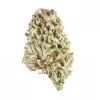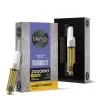Sabinene, a terpene with a distinctive aroma and potential therapeutic properties, has been gaining recognition in the realm of natural compounds.
In this article, we delve into the frequently asked questions about sabinene, its diverse effects, and its presence in various botanical sources. From its molecular structure to its potential impacts on health and well-being, we'll uncover the essential aspects of this intriguing compound.
What is the Sabinene Terpene?
Sabinene is classified as a monoterpene due to its structure, which consists of two isoprene units. It is characterized by a unique aroma profile that combines spicy, citrusy, and piney notes. This terpene is found in various plant species, including cannabis, though it typically appears in relatively small amounts.
One of the fascinating aspects of sabinene is its presence in a wide range of plants beyond cannabis. It is notably abundant in forest trees such as Norway spruce and Holm oak trees. In addition to these, sabinene can also be found in plants like juniper, cloves, nutmeg, black pepper, cardamom, and carrot seeds.
Its aromatic properties contribute to the overall scent and taste of these plants, adding complexity to their sensory experience. Sabinene is a terpene with a distinct spicy, citrusy, and piney aroma profile. It is found in various plants, including cannabis strains like "haze," as well as forest trees and spices.
While its effects in cannabis are still being explored, its antioxidant and antimicrobial properties offer potential health-related applications. As research continues, a deeper understanding of sabinene's role in plants and its potential benefits may emerge.

What Does Sabinene Do?
Sabinene possesses a range of potential biological activities and effects. While its precise mechanisms of action and full scope of benefits are still under investigation, existing research suggests several roles and functions that sabinene may play in different contexts.
Some individuals use sabinene-rich essential oils in aromatherapy practices. The spicy and citrusy aroma of sabinene may promote relaxation and stress relief when diffused into the air. For instance, using tea tree oil containing sabinene in an air diffuser could create a soothing and calming environment.
It's essential to emphasize that while these potential effects are based on available research, much of the information is still in the early stages of investigation.
As the scientific community conducts more comprehensive studies, a clearer understanding of sabinene's mechanisms of action and its specific benefits will likely emerge. Additionally, individual responses to sabinene and its effects can vary, highlighting the complexity of these interactions within the body.
Diverse Plant Sources of Sabinene: Variability and Applications
Sabinene can be found in various plants, but its concentration can vary widely depending on the species and even the specific cultivar of the plant. Some plants that are known to contain relatively higher levels of sabinene include:
|
Type |
Description |
Additional Information |
|---|---|---|
|
Juniperus species |
Trees and shrubs whose essential oils contain sabinene |
Includes J. communis and J. virginiana. Oils used in gin, perfumes, soaps. |
|
Piper nigrum |
Black pepper plant |
Sabinene comprises up to 1/3 of pepper essential oil. Provides spicy aroma. |
|
Taxodium distichum |
Bald cypress tree |
Leaf oil high in sabinene, used in cosmetics and perfumes. |
|
Salvia officinalis |
Common sage herb |
Sage oil contains substantial sabinene. Used in food and aromatherapy. |
|
Ocimum basilicum |
Sweet basil herb |
Up to 50% sabinene in essential oil. Provides aroma of fresh basil. |
Role and Effects of the Sabinene Terpene
Sabinene is a terpene that plays a significant role in the aromatic and functional diversity of various plants. This organic compound, characterized by its peppery, citrusy, and piney aroma, is found in plants ranging from cannabis to forest trees and culinary herbs.
While research into its effects is ongoing, sabinene is believed to offer a range of potential benefits and actions.
Sabinene contributes to the distinctive fragrance and flavor of plants in which it is present. This aromatic identity is pivotal in attracting pollinators, deterring herbivores, and aiding plants in communicating with their environment.
The sabinene terpene is a versatile terpene with a multifaceted role in both plant biology and potential human health. While it imparts aroma and flavor to plants and has shown promise in various applications, further research is needed to fully elucidate its mechanisms of action and therapeutic potential.
As the scientific community deepens its understanding of sabinene's effects, its applications across multiple fields, including botany, aromatherapy, and health sciences, may continue to expand.
Some benefits of the sabinene terpene are:
-
Aromatic diversity
-
Anti-inflammatory potential
-
Antioxidant properties
-
Antimicrobial effects
-
Aromatherapeutic uses
Sabinene in Nature and Botanical Sources
Sabinene, a distinctive terpene renowned for its intriguing combination of peppery, citrusy, and piney aromas, holds a significant role in shaping the aromatic tapestry of diverse botanical sources, with a special focus on spice plants. This aromatic molecule contributes not only to the sensory experience of these plants but also to their potential effects on health and well-being.
Among its notable contributions, sabinene enriches the aromatic complexity of plants, creating fragrances that range from spicy to zesty. This diversity of scents serves vital ecological functions, attracting pollinators and repelling herbivores, while also allowing plants to communicate with their surroundings.
Beyond scent, sabinene plays a key role in defining the flavor profiles of various botanicals, especially in the realm of spice plants. Black pepper, cardamom, nutmeg, juniper, and carrot seeds are prime examples of spice plants that owe their distinct tastes to the presence of sabinene.
The significance of the sabinene terpene extends beyond its sensory attributes. It offers potential health benefits due to its antioxidant, anti-inflammatory, and antimicrobial properties. While these effects are promising, ongoing research seeks to unveil the full scope of its physiological impacts.
From coniferous trees like Norway spruce and Holm oak to culinary and medicinal herbs, sabinene's presence underscores its essential role in the natural world.
Whether contributing to aromatherapy practices through essential oils or participating in ecological interactions by attracting beneficial organisms, sabinene continues to captivate researchers and enthusiasts alike, offering a glimpse into the intricate web of botanical diversity.
What is Sabinene in Weed?
While typically present in smaller quantities compared to other terpenes, sabinene plays a role in enhancing the aromatic diversity of various cannabis strains.
This terpene is most notably associated with "haze" strains, which are known for their complex scent profiles. Strains with higher concentrations of sabinene may have woody, citrusy, or minty notes, adding complexity to the overall scent and flavor of the cannabis plant.
In the context of cannabis, sabinene's presence aligns with the plant's evolutionary strategy of attracting pollinators and deterring potential threats. The peppery and citrusy notes of sabinene, combined with other terpenes, create a dynamic scent bouquet that can intrigue human senses as well.
While sabinene's presence enriches the olfactory experience of cannabis, its potential effects and interactions with other compounds within the plant are still subjects of ongoing research.

Is Sabinene Polar or Non-Polar?
Sabinene is a non-polar molecule due to its symmetrical structure and equal sharing of electrons between its constituent atoms.
Comprising carbon and hydrogen atoms, sabinene's molecular arrangement leads to a balanced distribution of electric charges, resulting in a lack of distinct positive or negative poles. This non-polar characteristic is reflected in its interactions with solvents and other molecules.
In a non-polar molecule like sabinene, the electronegativity of its constituent atoms is relatively uniform. As a consequence, sabinene shows a minimal affinity for polar solvents, such as water, and prefers nonpolar solvents, like oils or hydrocarbons, for dissolution.
Sabinene's non-polar nature plays a role in its behavior in various contexts, including its solubility properties and interactions with other non-polar molecules. Its lack of polarity also has implications for its ability to cross lipid membranes, which is relevant in fields such as pharmacology and biochemistry.
Is Sabinene Safe?
Sabinene is generally considered safe for most people when used in moderate amounts and in its natural forms, such as those found in spices and plants.
However, individuals with sensitivities, allergies, or specific medical conditions should exercise caution and seek guidance from medical professionals before using products containing concentrated sabinene, particularly essential oils, to ensure their safety and well-being.
As with any natural compound, individual reactions can vary. Some people might be more sensitive to sabinene's aroma or components. If you experience any adverse reactions like skin irritation, respiratory discomfort, or allergic responses, it's advisable to discontinue use and consult a healthcare professional.
Health Benefits of Sabinene
Sabinene, a distinctive terpene found in various botanical sources, has garnered attention for its potential health benefits, although a deeper understanding of its mechanisms and applications is still in progress.
Among its promising attributes, sabinene exhibits antioxidant properties that could help combat oxidative stress, thereby contributing to cellular health and potentially reducing the risk of chronic ailments associated with oxidative damage.
Moreover, emerging studies suggest potential anti-inflammatory effects, hinting at sabinene's role in managing conditions linked to inflammation, such as cardiovascular diseases and arthritis.
Another intriguing facet of sabinene is its demonstrated antimicrobial properties, particularly evident in certain essential oils like juniper oil. This quality opens up possibilities for its use as a natural ingredient in skincare formulations and eco-friendly cleaning solutions.
Beyond its functional attributes, sabinene-rich essential oils have found a place in the realm of aromatherapy, where their aromatic characteristics are harnessed to promote relaxation, alleviate stress, and enhance overall mood.
While sabinene presents these potential health benefits, it's important to approach the information with a balanced perspective. The scientific community is actively exploring sabinene's intricate interactions within the human body, and further research is needed to substantiate its effects conclusively.

Does Sabinene Cause Anxiety?
The effects of aromatic compounds, including terpenes like sabinene, on emotions and mood can vary widely from person to person. While some individuals might find the aroma of sabinene-containing products calming and soothing, others may have different responses.
If you are concerned about the potential effects of sabinene or any aromatic compound on your anxiety levels, it's recommended to start with a low concentration to gauge your individual response.
Additionally, if you have a history of anxiety or sensitivities, it's a good idea to consult with a healthcare professional before incorporating new aromatherapy practices into your routine. Always consider your own comfort and preferences when using aromatic compounds for therapeutic purposes.
Sabinene and Digestive Health
Sabinene has been linked to potential contributions to digestive health, although more research is needed to fully understand its effects. While specific effects on human digestion have not been extensively studied, sabinene's presence in certain botanical sources, particularly spice plants, suggests a possible role in supporting digestive processes.
Sabinene's aromatic properties also make it a common component in various essential oils used in aromatherapy and natural wellness practices. Inhalation of these oils might indirectly contribute to relaxation, stress reduction, and overall well-being, which can indirectly impact digestive health by alleviating stress-related gastrointestinal symptoms.
While sabinene's potential role in supporting digestive health is intriguing, it's important to approach these claims with caution and await further scientific investigations.
If you're interested in incorporating sabinene-rich foods, spices, or essential oils into your diet or wellness routine, it's advisable to do so in moderation and consult with healthcare professionals, particularly if you have existing digestive conditions or sensitivities.
Aromatic Influence: How Sabinene Shapes Sensory Experiences
Aromatic compounds like sabinene play a fascinating role in shaping sensory experiences, contributing to the intricate tapestry of flavors and aromas in various natural sources. Sabinene is known for its distinctive peppery, citrusy, and piney aroma.
This aromatic profile not only defines the character of plants that contain it but also adds depth and complexity to culinary, therapeutic, and even environmental encounters.
In the realm of aromatherapy and wellness, sabinene-rich essential oils take center stage. The volatile nature of terpenes like sabinene makes them ideal for diffusion, allowing their aromatic molecules to waft through the air and engage our olfactory senses.
Sabinene's aroma has been associated with relaxation, stress reduction, and mood enhancement. Inhaling sabinene-rich essential oils can transport individuals to serene mental landscapes, offering moments of respite in our often-hectic lives.
While sabinene's aromatic influence is intriguing and diverse, it's important to remember that individual perceptions of aroma can vary widely. Personal memories, cultural backgrounds, and sensitivities all shape how we interpret and respond to scents.
As sabinene finds its way into culinary creations, therapeutic practices, and the great outdoors, it weaves a fragrant thread through our sensory journey, inviting us to explore and savor the world around us in a uniquely aromatic way.

Molecular Structure: Decoding Sabinene's Blueprint
Sabinene, a naturally occurring bicyclic monoterpene, possesses a captivating molecular structure that underlies its distinctive properties and contributions to various botanical sources.
With the chemical formula C10H16, sabinene is a compound of ten carbon atoms and sixteen hydrogen atoms, its elegant arrangement giving rise to its intriguing characteristics.
This monoterpene's presence in some plants adds to their aromatic allure and might play roles in their ecological functions, such as defense mechanisms or interactions with other organisms.
Sabinene Handling and Considerations
When dealing with sabinene, a compound known for its aromatic and potential therapeutic properties, it's important to approach its use with care, consideration, and moderation.
Is Sabinene Toxic?
Sabinene is generally considered safe for most individuals when used in appropriate amounts. It is a naturally occurring compound found in various plants and essential oils, and it is commonly used in culinary, aromatherapy, and therapeutic applications.
Sabinene is not known to be highly toxic or harmful when used as directed.
Is Sabinene Flammable?
Yes, sabinene is flammable. It is important to handle sabinene and products containing it with caution, avoiding exposure to open flames, sparks, or high temperatures to prevent fire hazards.
Final Thoughts on Sabinene
Sabinene, a terpene with its unique spicy aroma and potential health-enhancing properties, continues to captivate researchers and wellness enthusiasts. Its presence in various plants and its potential effects on digestion and well-being make it a subject of significant interest.
As our understanding of sabinene evolves through scientific inquiry, we uncover new dimensions of its effects and applications, showcasing its potential to enrich sensory experiences and contribute to holistic well-being.










